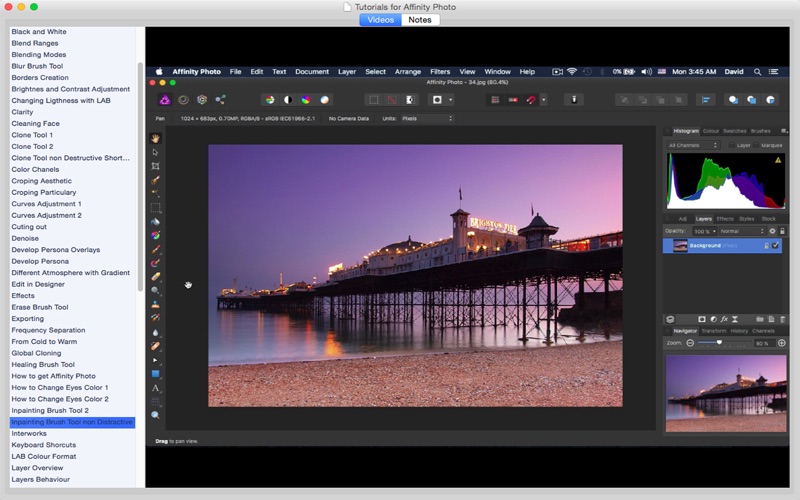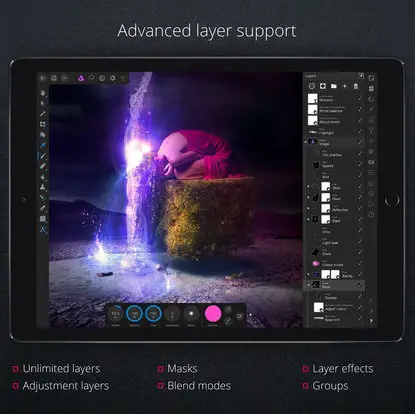
- AFFINITY PHOTO APP ON IOS VS PHOTOS FOR MAC
- AFFINITY PHOTO APP ON IOS VS PHOTOS PRO
- AFFINITY PHOTO APP ON IOS VS PHOTOS SOFTWARE
- AFFINITY PHOTO APP ON IOS VS PHOTOS WINDOWS 7
The interface of Affinity Photo is based on panels, which you can hide or display, and place wherever you want. Affinity Photo Develop Persona – a dedicated workspace for RAW editing Layer management is extremely efficient and well-organized. They are called Personas and address specific editing tasks such as editing RAW files, liquifying (image manipulation), HDR tone mapping, and exporting images.Įach workspace comes with a separate set of tools and you can mix the results of each editing flow. Unlike Pixelmator, Affinity is entirely dedicated to photography and its workspaces are organized accordingly. The Photography workspace – Credit photo /pro/ Workspace and user interface in Affinity PhotoĪffinity Photo provides separate workspaces too. You won’t have a steep learning curve with Pixelmator Pro. This keeps the interface airy and provides a good workflow.
AFFINITY PHOTO APP ON IOS VS PHOTOS PRO
Pixelmator Pro groups the tools for designers, painters, and illustrators in separate workspaces as well.

Here you’ll find tools for color adjustments, histograms, presets, layer management, and other tools a photographer wants to have at hand.

Photographers have a dedicated workspace called Photography. However, the interface is customizable and you can place the tools wherever you need them to be. If you need advanced tools you have to look deeper into submenus. The app addresses beginners as well as professional photographers and focuses on the aspect and utility rather than complicated controls. Its interface is intuitive, stylish, and visual. Pixelmator Pro has the shine of Apple apps. Workspace and user interface in Pixelmator Pro You can use it with iCloud, Apple Pencil, and others. The photo editor integrates with other Apple apps too. Therefore, you can mix the image organizing features of Photos with the powerful image editing features of Pixelmator Pro.
AFFINITY PHOTO APP ON IOS VS PHOTOS FOR MAC
The good news for Mac users is that Pixelmator Pro also works as an extension of Apple Photos. But who wants to learn to use a different app for each device? The producer offers a different app to iPad users, Pixelmator Photo. Pixelmator Pro works only with macOS 10.14 Mojave or later and is optimized for the new M1-powered Macs.
AFFINITY PHOTO APP ON IOS VS PHOTOS WINDOWS 7
It works with macOS 10.9 or later, Windows 7 or later, and iPad Air 2 or above with iOS 12 or above. But if you’re using a Windows system or an iPad, you can only choose Affinity Photo. If you’re a Mac user, you have no problem choosing either Affinity Photo or Pixelmator Pro.
AFFINITY PHOTO APP ON IOS VS PHOTOS SOFTWARE
So which one is the better choice for a professional photographer? We need more details to come to a conclusion.ĭownload our Free ebook: Quick Start Guide to Affinity Photo The Battle of Requirements: Pixelmator PRO vs Affinity Photo 2021īefore choosing your photo editing software you need to be sure it will work on your device. Affinity Photo costs $50 and Pixelmator Pro costs $39.99. There isn’t much price difference either.


Neither provides tethered shooting or image management tools. Also, they provide tools for graphic design so you don’t need another program to add text, paint over photos, and create collages. Both can be considered Photoshop alternatives, but none of them are, of course, near being industry standard, as that spot is solely held by Adobe Photoshop. In this post on Affinity Photo vs Pixelmator Pro we compare two competitive photo editors you should consider.īoth Affinity Photo and Pixelmator Pro provide exquisite photo adjustments designed to help you bring to life your artistic vision. Thus it’s important to have a photo editor that fits your requirements and provides a friendly and creative environment. Others are part of an exhaustive artistic process that delivers artworks, collages, and multimedia pieces.Įven when photos don’t need any retouches you still have to prepare them for print, resize them for social media, add your signature, or edit metadata. Some photos need just small adjustments to fix lighting, remove noise, or enhance colors. Post-processing is an essential step in a photographer’s workflow.


 0 kommentar(er)
0 kommentar(er)
